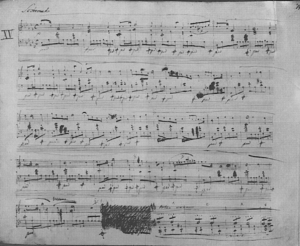Raindrop Prelude facts for kids
The Prelude Op. 28, No. 15, by Frédéric Chopin is often called the "Raindrop" prelude. It is one of 24 short musical pieces Chopin wrote. This prelude is the longest of them all, usually lasting between five and seven minutes. Many people think it sounds like raindrops because of a repeating note, A-flat, that you can hear throughout the music.
How it was Written
Some of Chopin's preludes were written in 1838. He was staying at a monastery in Valldemossa, on the island of Majorca, with his friend George Sand.
One evening, George Sand and her son, Maurice, were returning from Palma, Majorca. There was a terrible rainstorm. When they arrived, Chopin was very worried. He cried, "Ah! I knew well that you were dead."
While he was playing the piano, Chopin had a dream. George Sand later wrote about it. She said Chopin dreamed he was "drowned in a lake." Heavy drops of icy water fell on his chest in a steady rhythm. When Sand pointed out that water drops were actually falling on the roof, Chopin said he hadn't heard them. He didn't like the idea that his music was just copying sounds. He believed his music took sounds from nature and turned them into beautiful musical ideas.
George Sand did not say which prelude Chopin played that night. But most music experts believe it was Prelude No. 15. This is because of the repeating A-flat note. It sounds like the gentle patter of rain.
Some people, like Frederick Niecks, have a different idea. He thought the music made him imagine the monastery courtyard. He pictured monks chanting sad prayers. They were carrying a departed brother to his final resting place in the dark of night.
What the Music Sounds Like
The "Raindrop" prelude begins with a calm and peaceful tune in D-flat major. Then, the music changes. It becomes a bit sadder and darker in C-sharp minor. The repeating A-flat note, which was there from the start, becomes even stronger and more noticeable.
After this sadder part, the prelude returns to the original calm tune. It's like a bad dream ending and a peaceful feeling returning. Music expert Frederick Niecks said the C-sharp minor part feels like a "bad dream." He felt that when the D-flat major part comes back, it's like the "smiling freshness of dear, familiar nature." He believed you can truly appreciate its beauty only after hearing the darker parts.
Related pages
See also
 In Spanish: Preludio, Op. 28, No. 15 (Chopin) para niños
In Spanish: Preludio, Op. 28, No. 15 (Chopin) para niños



